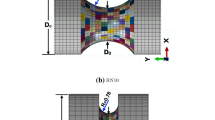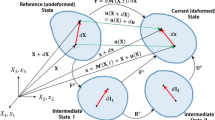Abstract
Strain localization bands (SLBs) that appear at early stages of deformation of magnesium alloys have been recently associated with heterogeneous activation of deformation twinning. Experimental evidence has demonstrated that such “Lüders-type” band formations dominate the overall mechanical behavior of these alloys resulting in sigmoidal type stress–strain curves with a distinct plateau followed by pronounced anisotropic hardening. To evaluate the role of SLB formation on the local and global mechanical behavior of magnesium alloys, an integrated experimental/computational approach is presented. The computational part is developed based on custom subroutines implemented in a finite element method that combine a plasticity model with a stiffness degradation approach. Specific inputs from the characterization and testing measurements to the computational approach are discussed while the numerical results are validated against such available experimental information, confirming the existence of load drops and the intensification of strain accumulation at the time of SLB initiation.

















Similar content being viewed by others
References
Pietruszczak S, Mróz Z (1981) Finite element analysis of deformation of strain-softening materials. Int J Numer Meth Eng 17(3):327–334. doi:10.1002/nme.1620170303
Tvergaard V, Needleman A, Lo KK (1981) Flow localization in the plane strain tensile test. J Mech Phys Solids 29(2):115–142. doi:10.1016/0022-5096(81)90019-3
Ortiz M, Leroy Y, Needleman A (1987) A finite element method for localized failure analysis. Comput Methods Appl Mech Eng 61(2):189–214. doi:10.1016/0045-7825(87)90004-1
Belytschko T, Fish J, Engelmann BE (1988) A finite element with embedded localization zones. Comput Methods Appl Mech Eng 70(1):59–89. doi:10.1016/0045-7825(88)90180-6
Batra RC, Kim CH (1992) Analysis of shear banding in twelve materials. Int J Plast 8(4):425–452. doi:10.1016/0749-6419(92)90058-K
Ramakrishnan N, Atluri SN (1994) Simulation of shear band formation in plane strain tension and compression using FEM. Mech Mater 17(2–3):307–317. doi:10.1016/0167-6636(94)90068-X
Shaw JA, Kyriakides S (1997) Initiation and propagation of localized deformation in elasto-plastic strips under uniaxial tension. Int J Plast 13(10):837–871. doi:10.1016/S0749-6419(97)00062-4
Tsukahara H, Iung T (1998) Finite element simulation of the Piobert-Lüders behavior in an uniaxial tensile test. Mater Sci Eng A 248(1–2):304–308. doi:10.1016/S0921-5093(97)00857-5
Koplik J, Needleman A (1988) Void growth and coalescence in porous plastic solids. Int J Solids Struct 24(8):835–853. doi:10.1016/0020-7683(88)90051-0
Kuroda M, Tvergaard V (2007) Effects of texture on shear band formation in plane strain tension/compression and bending. Int J Plast 23(2):244–272. doi:10.1016/j.ijplas.2006.03.014
Jia N, Roters F, Eisenlohr P, Kords C, Raabe D (2012) Non-crystallographic shear banding in crystal plasticity FEM simulations: example of texture evolution in \(\alpha \)-brass. Acta Mater 60(3):1099–1115. doi:10.1016/j.actamat.2011.10.047
Jia N, Eisenlohr P, Roters F, Raabe D, Zhao X (2012) Orientation dependence of shear banding in face-centered-cubic single crystals. Acta Mater 60(8):3415–3434. doi:10.1016/j.actamat.2012.03.005
Paul H, Morawiec A, Driver JH, Bouzy E (2009) On twinning and shear banding in a Cu-8 at.% Al alloy plane strain compressed at 77 K. Int J Plast 25(8):1588–1608. doi:10.1016/j.ijplas.2008.10.003
Hazeli K, Cuadra J, Vanniamparambil PA, Kontsos A (2013) In situ identification of twin-related bands near yielding in a magnesium alloy. Scripta Mater 68(1):83–86. doi:10.1016/j.scriptamat.2012.09.009
Aydıner CC, Telemez MA (2014) Multiscale deformation heterogeneity in twinning magnesium investigated with in situ image correlation. Int J Plast 56:203–218. doi:10.1016/j.ijplas.2013.12.001
Hazeli K, Cuadra J, Streller F, Barr CM, Taheri ML, Carpick RW, Kontsos A (2015) Three-dimensional effects of twinning in magnesium alloys. Scripta Mater 100:9–12. doi:10.1016/j.scriptamat.2014.12.001
Barnett MR, Nave MD, Ghaderi A (2012) Yield point elongation due to twinning in a magnesium alloy. Acta Mater 60(4):1433–1443. doi:10.1016/j.actamat.2011.11.022
Changizian P, Zarei-Hanzaki A, Ghambari M, Imandoust A (2013) Flow localization during severe plastic deformation of AZ81 magnesium alloy: micro-shear banding phenomenon. Mater Sci Eng A 582:8–14. doi:10.1016/j.msea.2013.05.069
Changizian P, Zarei-Hanzaki A, Abedi HR (2012) On the recrystallization behavior of homogenized AZ81 magnesium alloy: the effect of mechanical twins and \(\gamma \) precipitates. Mater Sci Eng, A 558:44–51. doi:10.1016/j.msea.2012.07.054
Chun YB, Davies CHJ (2011) Texture effect on microyielding of wrought magnesium alloy AZ31. Mater Sci Eng A 528(9):3489–3495. doi:10.1016/j.msea.2011.01.046
Fatemi-Varzaneh SM, Zarei-Hanzaki A, Cabrera JM (2011) Shear banding phenomenon during severe plastic deformation of an AZ31 magnesium alloy. J Alloy Compd 509(9):3806–3810. doi:10.1016/j.jallcom.2011.01.019
Li X, Yang P, Wang LN, Meng L, Cui F (2009) Orientational analysis of static recrystallization at compression twins in a magnesium alloy AZ31. Mater Sci Eng A 517(1–2):160–169. doi:10.1016/j.msea.2009.03.045
ABAQUS (2013) User’s manual version 6.13. Dassault Systems, Pawtucket
Cazacu O, Plunkett B, Barlat F (2006) Orthotropic yield criterion for hexagonal closed packed metals. Int J Plast 22(7):1171–1194. doi:10.1016/j.ijplas.2005.06.001
Lee M-G, Wagoner RH, Lee JK, Chung K, Kim HY (2008) Constitutive modeling for anisotropic/asymmetric hardening behavior of magnesium alloy sheets. Int J Plast 24(4):545–582. doi:10.1016/j.ijplas.2007.05.004
Ramaswamy S, Aravas N (1998) Finite element implementation of gradient plasticity models Part II: gradient-dependent evolution equations. Comput Methods Appl Mech Eng 163(1–4):33–53. doi:10.1016/S0045-7825(98)00027-9
de Borst R, Sluys LJ LJ (1993) Fundamental issues in finite element analyses of localization of deformation. Eng Comput 10(2):99–121. doi:10.1108/eb023897
Needleman A (1988) Material rate dependence and mesh sensitivity in localization problems. Comput Methods Appl Mech Eng 67(1):69–85. doi:10.1016/0045-7825(88)90069-2
Niezgoda SR, Kanjarla AK, Beyerlein IJ, Tomé CN (2014) Stochastic modeling of twin nucleation in polycrystals: an application in hexagonal close-packed metals. Int J Plast 56:119–138. doi:10.1016/j.ijplas.2013.11.005
Yoo MH (1981) Slip, twinning, and fracture in hexagonal close-packed metals. Metall Trans A 12(3):409–418. doi:10.1007/bf02648537
Beyerlein IJ, Capolungo L, Marshall PE, McCabe RJ, Tomé CN (2010) Statistical analyses of deformation twinning in magnesium. Phil Mag 90(16):2161–2190. doi:10.1080/14786431003630835
Yu Q, Jiang Y, Wang J (2015) Cyclic deformation and fatigue damage in single-crystal magnesium under fully reversed strain-controlled tension-compression in the [1 0 0] direction. Scripta Mater 96:41–44. doi:10.1016/j.scriptamat.2014.10.020
Mo C, Wisner B, Cabal M, Hazeli K, Ramesh K, El Kadiri H, Al-Samman T, Molodov K, Molodov D, Kontsos A (2016) Acoustic emission of deformation twinning in magnesium. Materials 9(8):662
Liu X, Jonas JJ, Li LX, Zhu BW (2013) Flow softening, twinning and dynamic recrystallization in AZ31 magnesium. Mater Sci Eng, A 583:242–253. doi:10.1016/j.msea.2013.06.074
Sun HB, Yoshida F, Ma X, Kamei T, Ohmori M (2003) Finite element simulation on the propagation of Lüders band and effect of stress concentration. Mater Lett 57(21):3206–3210. doi:10.1016/S0167-577X(03)00036-3
Oliver J (1996) Modelling strong discontinuities in solid mechanics vis strain softening constitutive equations. Part 1: fundamentals. Int J Numer Methods Eng 39(21):3575–3600
Hielscher R, Schaeben H (2008) A novel pole figure inversion method: specification of the MTEX algorithm. J Appl Crystallogr 41(6):1024–1037. doi:10.1107/S0021889808030112
Acknowledgements
The corresponding author acknowledges the financial support provided by the National Science Foundation through the CMMI #1434506 award to Drexel University. He also acknowledges the technical support received under the National Aeronautics and Space Administration Space Act Agreement, No. SAA1-19439 with Langley Research Center. The results reported were obtained by using computational resources supported by Drexel’s University Research Computing Facility. This investigation was also supported by the funds received in terms of fellowship to M. Cabal from the Greater Philadelphia Region Louis Strokes Alliance for Minority Participation.
Author information
Authors and Affiliations
Corresponding author
Appendix
Appendix
Material
Two sets of samples were machined from two different commercial magnesium AZ31 alloy (3 wt.% Al and 1 wt.% Zn) plates. The notched specimens were prepared from a 25.4 mm thick plate in the soft annealed condition (O temper). Two cubes were extruded from the plate and then compressed to 5% load in either the normal to rolling (ND) or transverse to rolling (TD) direction. The cubes were later held at 500\({^{\circ }}\)C for 50 h to increase their grain size. Texture and grain size were measured in samples cut from the normal direction. The straight specimens were prepared from a 50.8 mm thick plate in H24 condition. Cubes were cut from the plate and heat treated to O temper at 350\({^{\circ }}\)C for 1 h. Both tensile specimens were machined from the cubes using Electrical Discharged Machining (EDM) according to ASTM E606.
Samples were mechanically ground using 800, 1200, and 2400 SiC papers. Subsequent polishing was carried out using an alcohol based diamond solution through a sequence of 6, 3, and 1 \(\mu \)m Buehler’s TriDent and Struers’ Nap polishing cloths. Polishing was completed using a mixed solution comprising of 25% MasterPrepTM Polishing Suspension (0.05 \(\mu \)m), 5% LiquinoxTM critical-cleaning liquid detergent, and 70% water. In each polishing step, ultrasonic cleansing was used to completely eliminate adhered particles from previous polishing courses. Specimens were then immersed in a chemical polishing solution comprised of 5% nitric acid, 15% acetic acid, 20% distilled water, and 60% ethanol for 3 s.
All EBSD data was collected with a Scanning Electron Microscope (SEM) FEI XL30 equipped with an EBSD detector, controlled by the TSL software. Grain information, including lattice orientations and grain size, were measured at intervals of 2 \(\mu \)m on a hexagonal grid by automated acquisition and processing of backscatter diffraction patterns. The accelerating voltage and working distance were set at 30 kV and 15 mm, respectively. EBSD data was post processed using MTEX algorithm in MATLAB platform [37].
Mechanical Testing
A speckle pattern was applied on the surface of samples before testing for DIC measurements. A white paint coating was sprayed using at aerosol canister, while black dots were scattered on top using an airbrush. The notched samples were tested using a MTS 858 table top system with a load cell of 3 kips (13.35 kN). The testing was carried out using displacement control, at a rate of 5.315 \(\times \) 10\(^{-4}\) in/s (1.35 \(\times \) 10\(^{-2}\) mm/s). Experiments of the ND and TD specimens both to failure and to a pre-determined value of engineering strain are reported in this article. DIC was carried out by an optical microscope with dual (2) cameras in concurrence with the commercial software VIC-3D (commercially available by Correlated Solutions, Inc.) monitored deformation in a Field of View (FOV) of 5 mm \(\times \) 6 mm size during two tension tests (Fig. 1). Along with the selected FOV, a narrower diagonal area marked in Fig. 1 was used to quantify the deformation of the shear band region only.
The straight specimens were tested with a screw-driven Gatan MTEST stage with a 2000 N load cell. The tests were conducted using displacement control with a rate of 0.1 mm/min. The Gatan stage has pre-tilted grips providing the capability for in-situ EBSD measurement testing inside of SEM. DIC measurements were attained using a GOM (Trillion) 5M dual cameras setup and the ARAMIS software.
Rights and permissions
About this article
Cite this article
Baxevanakis, K.P., Mo, C., Cabal, M. et al. An integrated approach to model strain localization bands in magnesium alloys. Comput Mech 61, 119–135 (2018). https://doi.org/10.1007/s00466-017-1480-6
Received:
Accepted:
Published:
Issue Date:
DOI: https://doi.org/10.1007/s00466-017-1480-6




